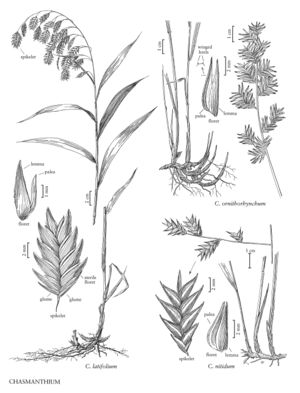Chasmanthium nitidum
Culms 40-120 cm, to 1 mm thick at the nodes, rarely branched, leafy for 80% of their height. Sheaths glabrous; collars glabrous; ligules 0.2-0.3 mm, entire; blades 9-16(33) cm long, 4-7 mm wide, lanceolate-fusiform, glabrous adaxially. Panicles (9)12-17(29) cm, open, erect; branches ascending to divergent; axils of panicle branches scabrous; pedicels 0.5-2 mm. Spikelets 12-24 mm long, (8)9-12(15) mm wide, with (5)7-9(11) florets, lower (0)1(2) florets sterile, fertile florets diverging to 45°. Lower glumes 3.1-5 mm, 7-9-veined; upper glumes 3-4.6 mm, (5)7-9-veined; calluses glabrous; fertile lemmas 5.5-8.5 mm, straight, 9-11-veined, keels not winged, scabridulous toward the apices; paleas 5-7.5 mm; anthers 1.9-2.4 mm, the length invariant within a spikelet. Caryopses 2.4-3 mm, enclosed at maturity. 2n = 24.
Distribution
S.C., N.C., Fla., Ala., Ga.
Discussion
Chasmanthium nitidum grows along stream and river banks, roadside ditches, and the margins of low, moist woods in the southeastern United States.
Selected References
None.
